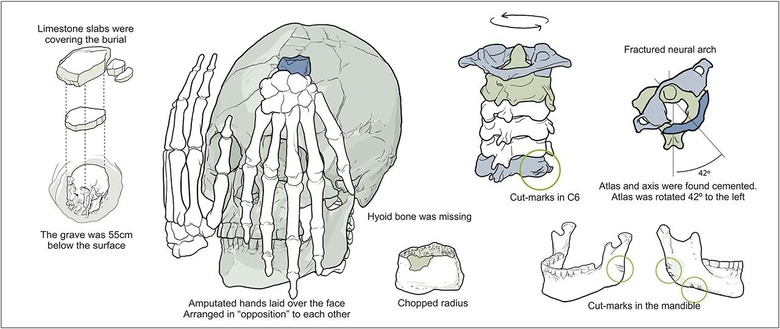Scientists Uncover New World's First Decapitation
A 9,000 year old human skull has been found with a pair of limbless hands cover its face in Brazil. The international team of researchers who've uncovered this head suggest that it is the oldest case of decapitation in the history of the New World. This skull was first discovered back in 2007 and has only now been confirmed to have been a case of decapitation. The original find was made at Lapa do Santo, an archaeological site in the Lagoa Santa karst in east-central Brazil. This site is known for its confirmed evidence of human occupation dating back around 11,000 years.
Scientists suggest that the area has evidence of human occupation as far back as 11.7–12.7 cal kyBP (95.4% interval) (again, that's around 12,000 years ago). The skull was put through an "ultra-filtered AMS age determination" which suggests an age just over 9,000 years.
HERO IMAGE: "Aerial view of the massif in which the rock shelter is located." (Skull illustration added, unofficial.)
Strontium analysis compares this skull to other local citizens of Lapa do Santo. Results have suggested that this skull was part of the local tribe. It's therefor suggested by researchers that this beheading wasn't a trophy kill, but a ritualistic endeavor.

ABOVE: The location of the site where the skull was found in Lagoa Santa. BELOW: "a) Pit shape; b) Arrangement of the hands over the skull."

Researchers suggest that Lapa do Santo's people used the head – and perhaps other bits and pieces not yet discovered – to express their beliefs. Beliefs, that is, in cosmological principals, life and death, and whatever else they happened to trust in so many thousands of years ago.

ABOVE: "Fig 5. Schematic representation of Burial 26 from Lapa do Santo." Drawing by Gil Tokyo.
Evidence points toward a "sophistication of mortuary rituals among hunter-gatherers" in the area during the early Archaic period.
You can learn more about this find in the paper "The Oldest Case of Decapitation in the New World (Lapa do Santo, East-Central Brazil)" authored by André Strauss, Rodrigo Elias Oliveira, Danilo V. Bernardo, Domingo C. Salazar-García, Sahra Talamo, Klervia Jaouen, Mark Hubbe, Sue Black, Caroline Wilkinson, Michael Phillip Richards, Astolfo G. M. Araujo, Renato Kipnis, and Walter Alves Neves.
This paper can be found in the scientific journal PLoS ONE under code doi:10.1371/journal.pone.0137456, as published on September 23rd, 2015.
